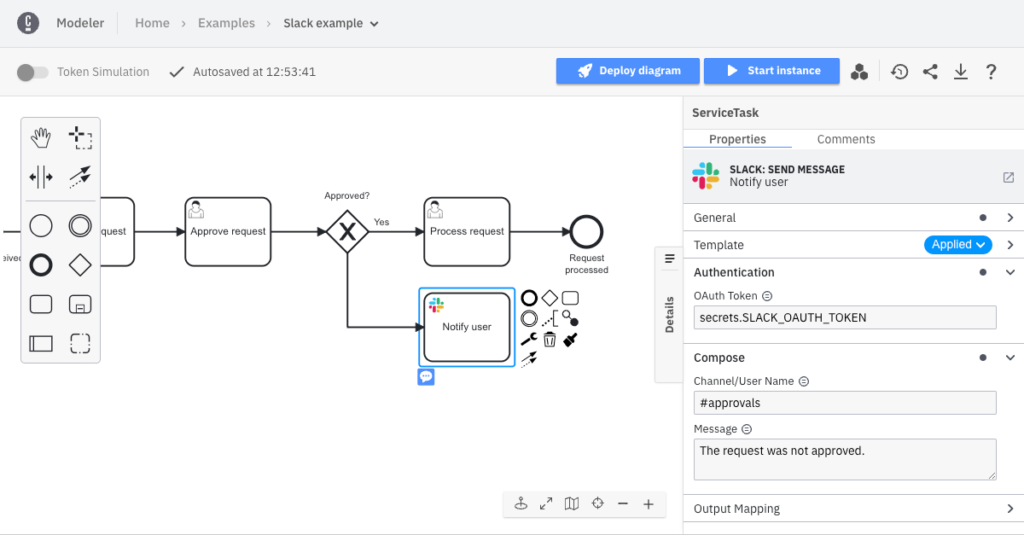If you’re using Camunda Platform 8, you might already be taking advantage of the REST Connector for making API calls or the SendGrid Connector for sending emails. Now we’re excited to announce an out-of-the-box Slack Connector that allows you to send messages to channels or users in your Slack workspace as part of your business processes. The Slack Connector is a convenient way to keep people in your organization up-to-date with important things happening in your business processes; for example, if a certain logical flow is triggered or if someone needs to take action on a specific task.
Camunda Platform 8’s out-of-the-box Connectors are designed to help you overcome one of the biggest hurdles to process orchestration: figuring out how the process should interface with different types of endpoints such as APIs, RPA bots, CRM and ERP platforms, user-facing applications, and so on. Most processes—even fairly simple ones—involve at least a few of these endpoints, and the level of complexity can grow very quickly. For example, if a process invokes an RPA bot, you need to know exactly what data the bot will need to execute its task.
Camunda Platform 8 orchestrates complex business processes across all of the different types of process endpoints in your organization, and Connectors are here to make it easier. They communicate with any system or technology, reducing the time it takes to model, implement, and automate business processes. They’re modular and designed for reuse, so your teams don’t have to reinvent the wheel every time they need to work with a particular endpoint. And they’re user-friendly; if you can add a task to a BPMN process diagram, you can use Connectors.
Connectors for everyone!
The Slack Connector requires a quick one-time setup process; after that, it’s as easy as adding Slack tasks to your BPMN process diagrams. The code that’s required to send a Slack message is built into the Connector, so you only have to provide a few configuration details, such as the name of the Slack channel or user that you want to send a message to.
This streamlined design makes Connectors ideal for low-code developers, business analysts, and other process designers who might not be adept at Java or other programming languages. Pro-code developers also benefit from the convenience of Connectors; instead of spending time writing and rewriting code to do a relatively simple action like sending a Slack message, they can focus on software development work that’s more complex or work that’s specialized for their company’s business.
Get ready to use the Slack Connector
A one-time setup is required before you can use the Slack Connector:
- Figure out your Slack workspace. A workspace is identified by a unique name such as https://myWorkspace.slack.com.
- Create a Slack app and install it in the workspace. The Connector communicates with Slack through a Slack app. Don’t worry, you don’t have to write or test any code; Slack provides a step-by-step process for creating an app. After the app is installed, copy its bot token (which is an OAuth token). The Connector will use this token to authenticate with the Slack API.
- Store the bot token as a secret in Camunda Platform 8. Follow our guide for creating secrets and name your secret something easy to read, like SLACK_OAUTH_TOKEN. You’ll reference this name when you use the Slack Connector in a BPMN diagram.
Use the Connector in a BPMN diagram
After you’ve set up the Slack app and stored the bot token in Camunda Platform 8, anyone in your organization can use the Slack Connector in their BPMN diagrams. To do so:
- Log in to Camunda Platform 8.
- Launch Web Modeler and create a new BPMN diagram or open an existing one.
- Click an element in the diagram and click the Append Connector context menu item to add a Connector task. Type Slack in the search box to filter the list of Connectors, or just scroll down and select the Slack Connector.
- In the task’s properties panel, set OAuth Token to the name of the secret that you created earlier, in the format secrets.SLACK_OAUTH_TOKEN.
- Set Channel/User Name to the Slack channel or name of the user that you want to send the message to. Channel names must start with a hash symbol (#). Usernames must start with an at sign (@).
- Set Message to the message that you’d like to send.

The channel, user name, and message can be static values, or you can use a FEEL expression to reference process variables or dynamically create values. For more information about using FEEL, visit the Slack Connector documentation.
You can apply text formatting to the messages that are sent via Slack Connector; check out the Slack API documentation to learn more.
Availability
The Slack Connector is already available for all Camunda Platform 8 SaaS users. For Self-Managed users, the Connector will be available in the Camunda Platform 8.1 release. Try it for yourself today by creating a free account.
Learn more about Connectors
Want to see more out-of-the-box Connectors? You can get your fill at CamundaCon! Join us October 5 and 6, virtually or in-person, to see how Camundi and Camunda partners are building a rich library of out-of-the-box Connectors for you to use in your own business processes.
If you can’t wait for CamundaCon, check out our recent Camunda Nation podcast, Camunda 8 Connectors: Reusable Integrations. Developer Advocate Josh Wulf talks with Principal Software Engineer Nico Rehwaldt about what Connectors are, how they relate to process modeling, and how you can get started.
To learn about the future of Connectors, watch Camunda Question Corner #22. Camunda Product Manager Preeti Nirwal joins Developer Advocate Nele Uhlemann to discuss our roadmap for out-of-the-box Connectors and the new Connector SDK.
